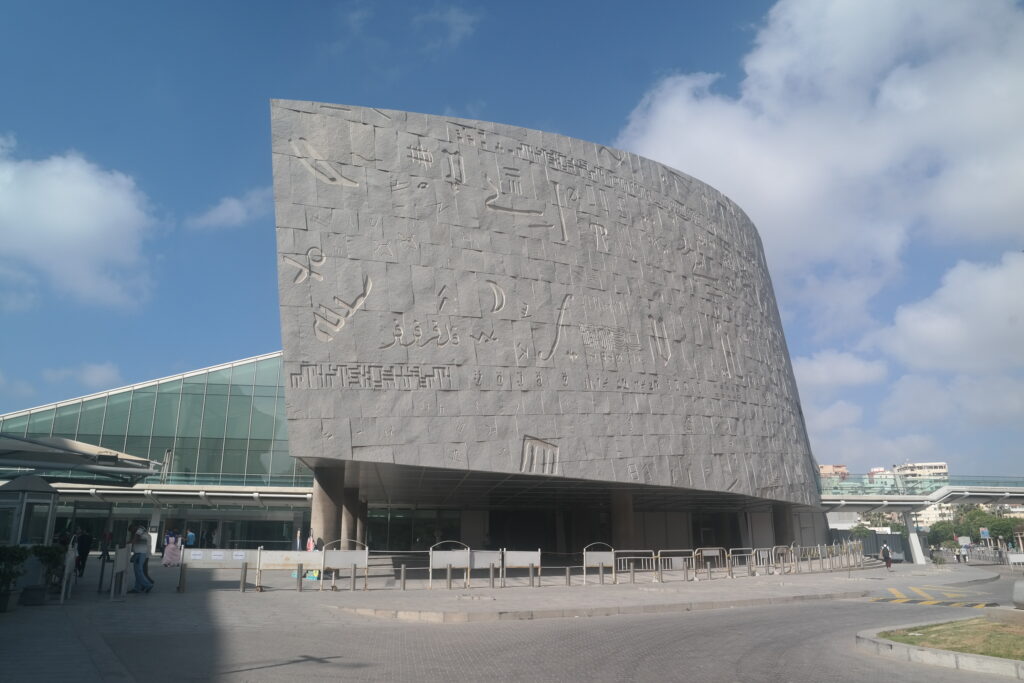Library of Alexandria:

One of the Largest and Most Famous Libraries of Antiquity and Modern Times
In ancient times, Alexandria was famous for its lighthouse, the tomb of Alexander the Great, and the Library of Alexandria, which was probably built in the 3rd century BC and became a center of education, science, and culture. It may have contained between 400,000 and 700,000 manuscripts, volumes, or papyrus scrolls from various fields. These included texts written in hieroglyphs, ancient cuneiform, Greek script, and works of ancient philosophers and scientists such as Archimedes, Euclid, Homer, and Aristotle.
The library was burned down in 48 BC during Julius Caesar’s rule amid a civil war and was completely destroyed by 270–275 AD.
The modern library stands at the same location as the ancient one. It was opened in 2002 with a unique design and is a major attraction for tourism and culture in Egypt. The building is designed to resemble the sun rising out of the water’s surface, featuring a slanting cylindrical shape with a massive circular wall inscribed with approximately 6,300 letters, words, and symbols from various ancient and modern world civilizations.
The library halls can accommodate around 8 million books spread over 9 levels (about 10 stories tall) with approximately 90 columns. Thanks to its unique design, natural light enters the reading rooms indirectly, providing pleasant illumination.
The library comprises six specialized libraries focused on arts and multimedia, including the Taha Hussein Library for the visually impaired, a children’s library, the Al-Nashq Library and Archives, a rare books section, and study centers such as calligraphy, manuscripts, civilization and Islamic studies, and the Alexandria Center for Hellenistic Studies.
Additionally, the library includes four museums:
-
The Antiquities Museum, one of the few museums worldwide exhibiting artifacts found at the library’s site,
-
A Manuscript Museum,
-
A Sadat Museum,
-
A Museum of the History of Science.
There is also a scientific planetarium center, a children’s science education research hall, an art center with about 17 permanent exhibitions, and a conference center.
The Library of Alexandria today stands as a symbol of knowledge, culture, and scholarly pursuit, bridging the rich heritage of the ancient world with modern academic and cultural life.
The Library of Alexandria in Egypt is one of the most iconic symbols of human knowledge and ancient civilization. Originally established in the 3rd century BCE, it was once the largest and most significant library of the ancient world. In 2025, the modern Bibliotheca Alexandrina continues this legacy by offering a space that celebrates education, science, culture, and global dialogue.
Table of Contents
ToggleA Legacy of Knowledge
The ancient Library of Alexandria was founded during the reign of Ptolemy I or Ptolemy II and aimed to collect every written work in existence. Scholars from around the Mediterranean came to study philosophy, astronomy, mathematics, and medicine. Although the original library was lost in antiquity—likely due to a series of fires and political conflicts—its spirit lives on through the modern reconstruction.
The modern Library of Alexandria, opened in 2002, revives the vision of a universal center for learning. It is home to millions of books, digital resources, rare manuscripts, and art exhibitions. As of 2025, it continues to evolve with new technologies and global partnerships.
Iconic Architecture
The architecture of the Bibliotheca Alexandrina is as breathtaking as its mission. Designed by the Norwegian firm Snøhetta, the library resembles a massive sun disc rising from the Earth. Its granite outer wall is engraved with characters from over 120 scripts, symbolizing global knowledge and diversity.
Inside, the building spans eleven levels with open reading spaces bathed in natural light. In 2025, it remains one of Egypt’s most visited architectural landmarks and a hub for educational tourism in Alexandria.
Why Visit in 2025?
With Egypt experiencing a surge in cultural tourism, 2025 is the perfect year to visit the Library of Alexandria. The library regularly hosts international exhibitions, academic conferences, and public lectures that attract scholars and travelers alike.
Whether you’re a history enthusiast, architecture lover, or curious traveler, a visit to the Library of Alexandria offers a chance to connect with one of humanity’s oldest intellectual legacies.
Conclusion
The Library of Alexandria in 2025 is more than just a building—it is a bridge between the ancient and modern worlds. Its rich history, inspiring architecture, and continued educational mission make it a must-visit destination for anyone exploring Egypt’s cultural treasures.
